
- Home
- India
- World
- Premium
- THE FEDERAL SPECIAL
- Analysis
- States
- Perspective
- Videos
- Sports
- Education
- Entertainment
- Elections
- Features
- Health
- Business
- Series
- In memoriam: Sheikh Mujibur Rahman
- Bishnoi's Men
- NEET TANGLE
- Economy Series
- Earth Day
- Kashmir’s Frozen Turbulence
- India@75
- The legend of Ramjanmabhoomi
- Liberalisation@30
- How to tame a dragon
- Celebrating biodiversity
- Farm Matters
- 50 days of solitude
- Bringing Migrants Home
- Budget 2020
- Jharkhand Votes
- The Federal Investigates
- The Federal Impact
- Vanishing Sand
- Gandhi @ 150
- Andhra Today
- Field report
- Operation Gulmarg
- Pandemic @1 Mn in India
- The Federal Year-End
- The Zero Year
- Science
- Brand studio
- Newsletter
- Elections 2024
- Events
Spices, banana leaves and clay vessels: The earthy flavours of Sindhudurg

As chef Dilip Bavkar at Coco Shambhala wielded his spoon, the kitchen transformed into an orchestra of aromas and sounds. Curry leaves and mustard seeds erupted with a percussive crackle, while the sizzle of onions commanded the spotlight. Aromatic hints of cumin, ginger, garlic, and green chillies wafted through the air like fragrant tendrils, drawing me closer.As he prepared Pithla,...
As chef Dilip Bavkar at Coco Shambhala wielded his spoon, the kitchen transformed into an orchestra of aromas and sounds. Curry leaves and mustard seeds erupted with a percussive crackle, while the sizzle of onions commanded the spotlight. Aromatic hints of cumin, ginger, garlic, and green chillies wafted through the air like fragrant tendrils, drawing me closer.
As he prepared Pithla, a Maharashtrian dish made from humble gram flour, Bavkar revealed, “It's a pasty curry that pairs perfectly with Jowar Bhakri and Thecha. Zunka is its drier counterpart, and we are cooking both today.” Pithla is simple to prepare. Heat oil, then add asafoetida, mustard seeds, and cumin seeds, letting them crackle. Stir in chopped garlic, ginger, green chillies, cilantro, and onions. Add turmeric, garam masala, red chilli powder, gram flour, and salt. Mash the mixture until crumbly, then add warm water and mix well. Garnish with cilantro and serve hot.
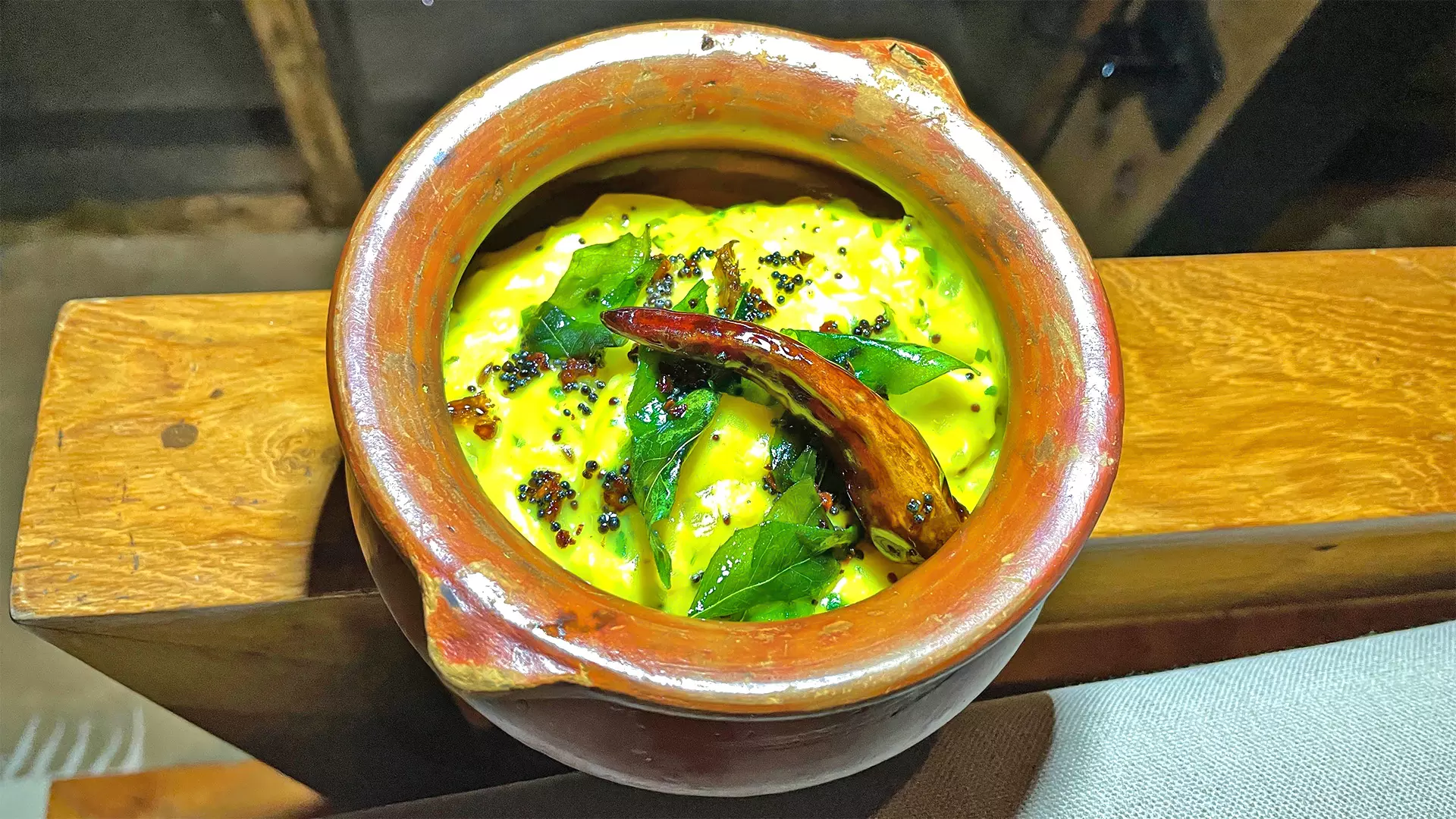
Pithla pairs perfectly with Jowar Bhakri and Thecha.
At Coco Shambhala, and in kitchens across Maharashtra, Thecha holds a revered place as a side condiment that elevates any meal. This spicy accompaniment is made from green chillies, complemented by garlic, herbs, peanuts, and a touch of coconut. The aroma of sizzling spices had barely begun to waft through the kitchen when chef Bavkar set another earthen pot on the open flame. This time, coconut oil blazed within, ready to embrace a free-range country chicken, its flesh seasoned with the secrets of generations. This dish, Kombdi Vade, resonates with Konkani flavours, cherished during special occasions like Dev Diwali, Gauri Ovase, and Shimga. A spicy coconut broth, enriched with the essence of the Konkan coast, gently envelops the chicken, ensuring a depth of flavour that can only be attained through slow cooking. Vade, fluffy lentil fritters, awaited their turn to be dunked in the rich broth, while solkadi, a cool and tart coconut-based drink, stood ready to refresh the palate between each fiery bite.
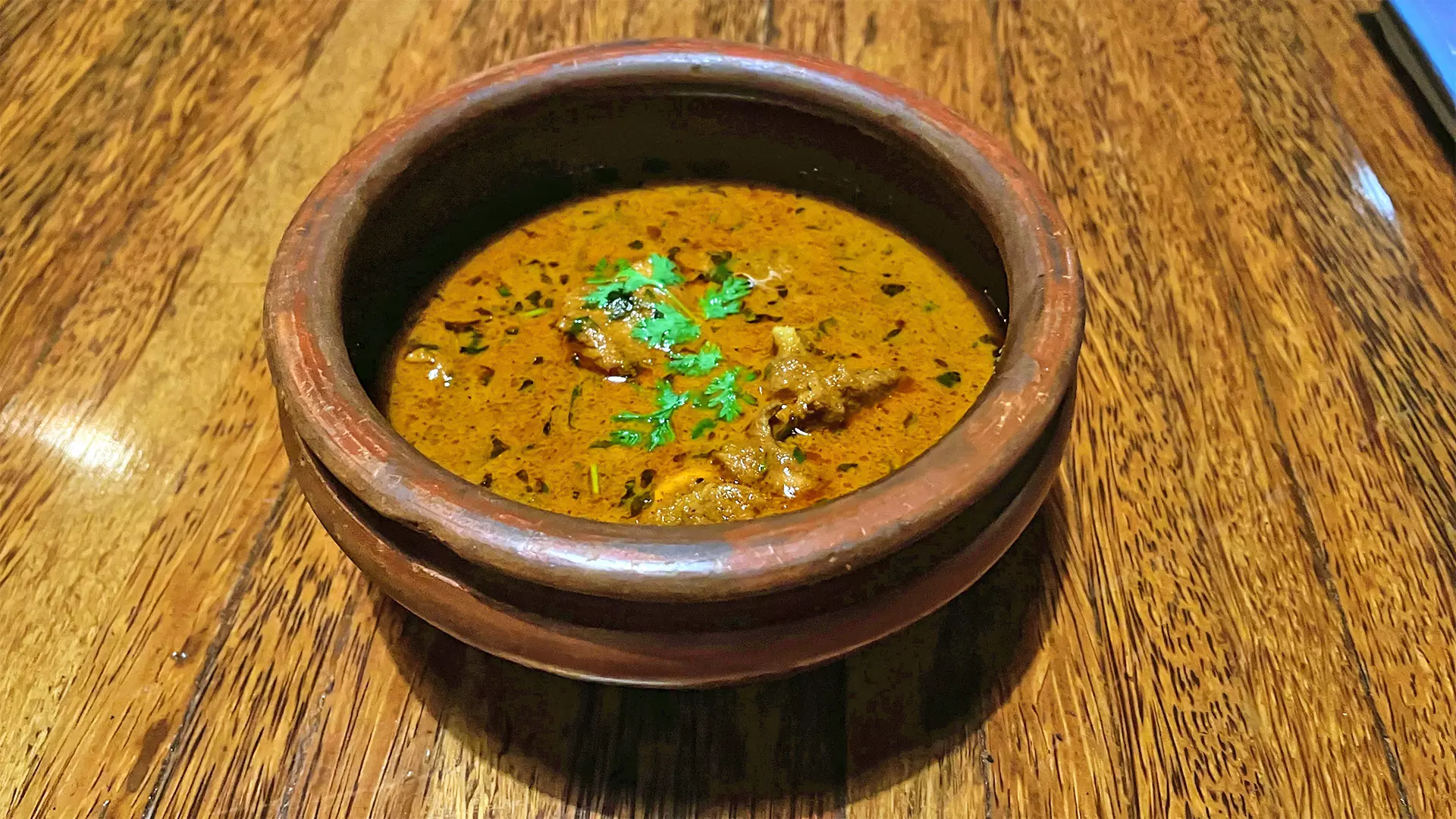
Kombdi Vade, resonates with Konkani flavours, cherished during special occasions like Dev Diwali, Gauri Ovase, and Shimga.
My eyes darted around the kitchen like a hummingbird flitting between blossoms. On one stove, kitchen staff presided over a medley of sizzling. There, an orange ambotik curry bubbled. Local prawns played the starring role, bathed in this sour-spicy sauce infused with the unique tingle of Konkani Sichuan peppercorns. Steaming bowls of rice stood by, ready to be the perfect canvas for this flavourful creation. Meanwhile, on another stove, a flatbread, the jawar bhakri, awaited its turn, its earthy aroma a counterpoint to the rich curry.
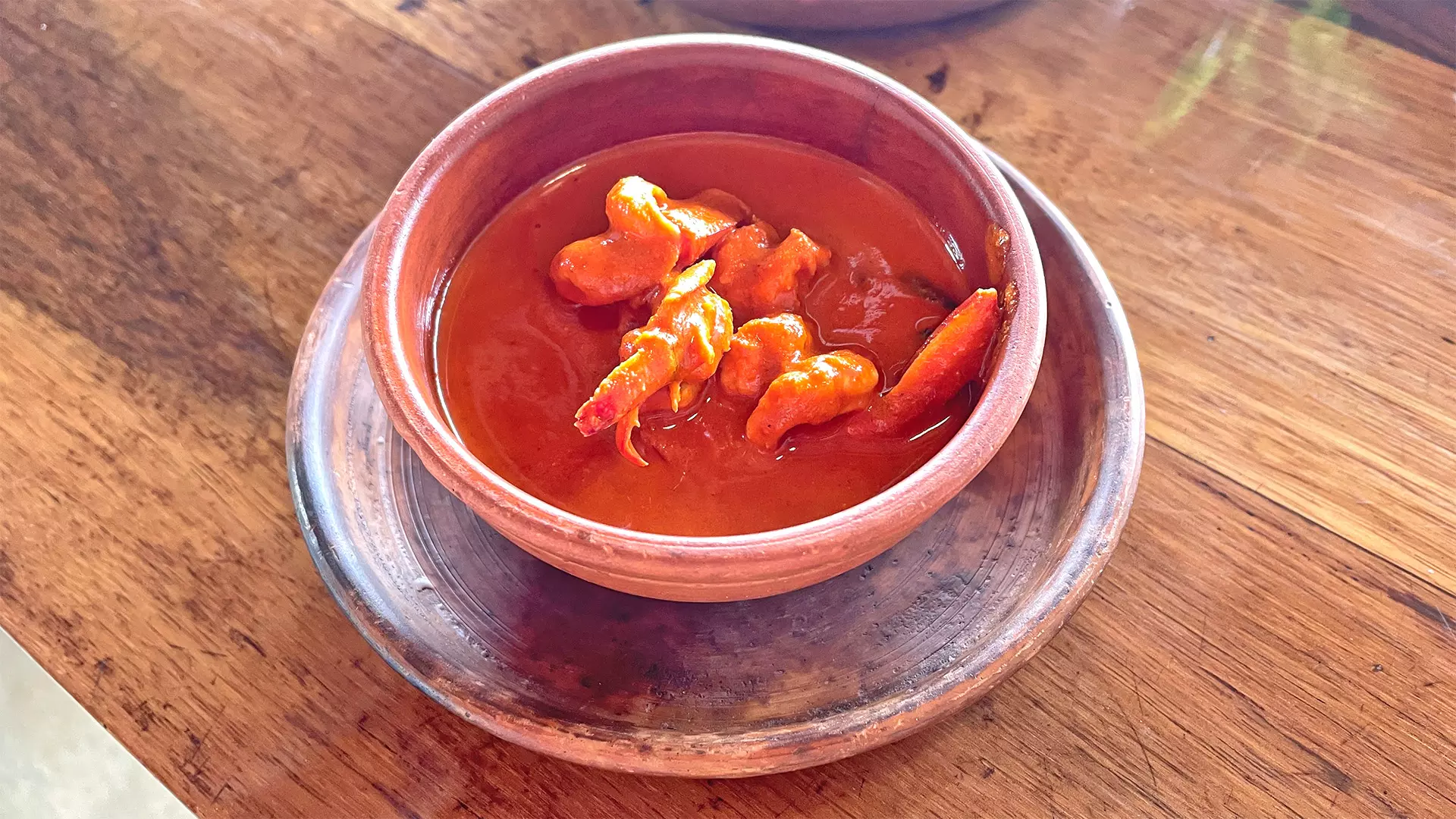
Ambotik Prawns, a piquant dish with a pronounced sourness, accented by local Sichuan peppercorns.
On yet another stove, Malvani magic bubbled away. Fresh crabs and clams, the very bounty of the Konkan coast, were undergoing a delicious transformation into classic Malvani dishes – Khekade and Tisre. Suhas, the F&B manager at Coco Shambhala, beamed with pride. Here, the seafood was as fresh as it gets – the catch of the day, delivered straight from the fishermen's nets and cooked within a few hours. This dedication to freshness, Suhas emphasised, was the cornerstone of Konkani cuisine, ensuring its authenticity and the perfect balance of flavours.
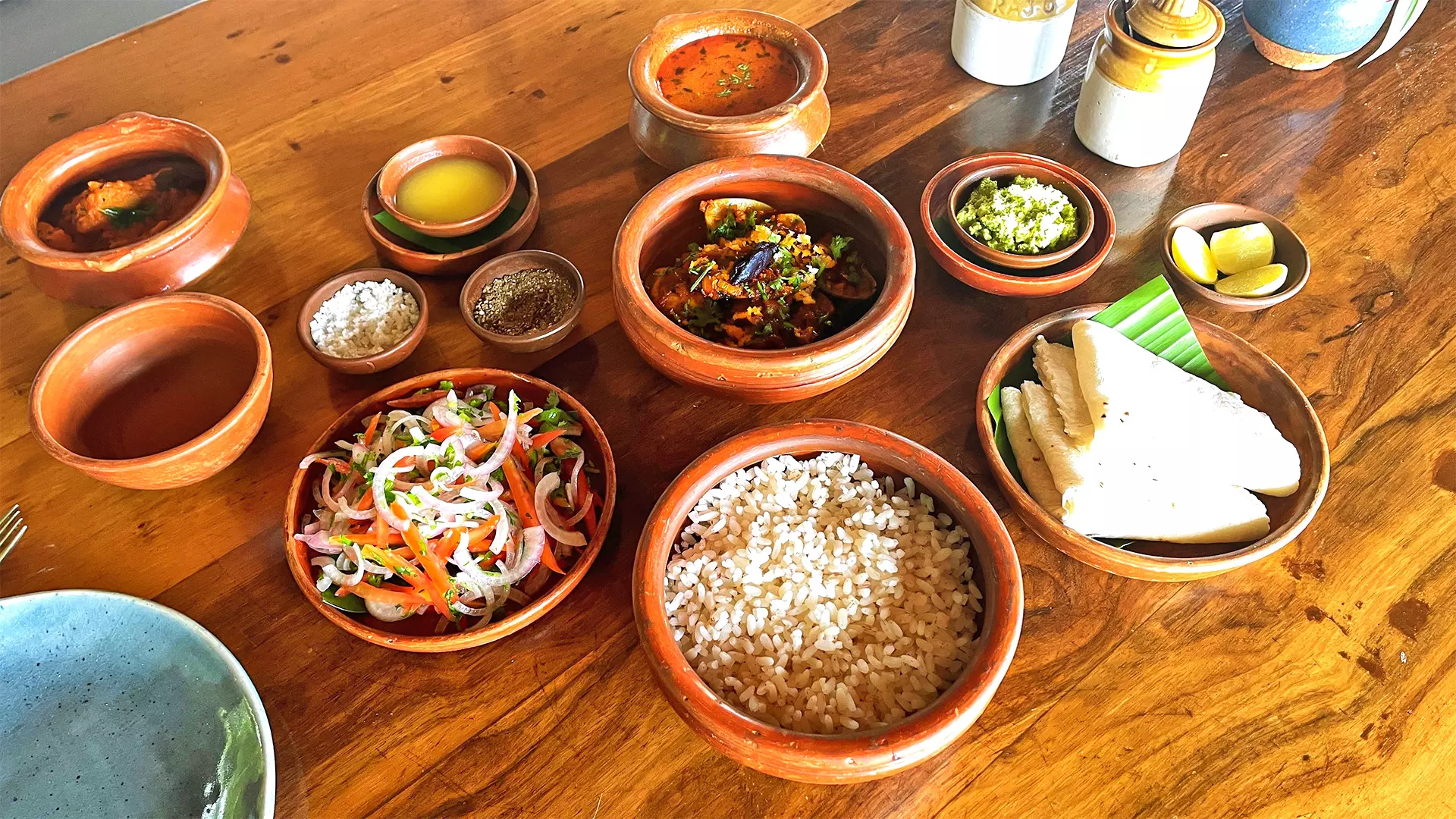
Freshness is the cornerstone of Konkani cuisine.
Bavkar's passion for cooking was evident as he revealed his secret to exquisite Malvani curries: a fresh, house-made masala. This intricate blend, he explained, is a balanced union of 14 ingredients. Dry red chillies provide the fiery base, poppy seeds add a touch of nuttiness, coriander and peppercorns offer warmth, and fennel seeds lend a subtle aniseed note. Cumin seeds anchor the spice profile, while mace, cloves, and cinnamon add layers of aromatic intrigue, and star anise, a star-shaped pod, offers a liquorice-like sweetness. Stone flower, nutmeg and turmeric contribute a textural element, whereas, asafoetida, a pungent resin with a garlicky aroma, completes the richness of flavours.
Bavkar passionately highlights the integral role of coconut in Malvani cuisine, a culinary tradition synonymous with the South Konkan region. While predominantly non-vegetarian, Malvani cuisine also boasts a rich array of vegetarian dishes, blending influences from Maharashtrian and Goan culinary traditions. Coconut takes centre stage in various forms—grated, dry-grated, fried, as paste, and as milk—lending richness and depth to dishes. Ingredients like kokum (amsul), tamarind, and mango further enhance the flavours. Despite its fiery reputation, not all Malvani dishes are intensely spicy; the Konkanastha Brahmin style showcases a milder, nuanced approach to cooking. Yet, no meal is truly complete without a dash of freshly caught and perfectly fried fish. While red snapper reigns supreme as the preferred catch, the bounty of the sea offers everything from crabs to clams. A standout in Malvan cuisine is the rava (semolina) coated fish. This local delicacy demands to be savoured hot and crispy, so it's always prepared last, ensuring that every bite delivers that signature crunch.
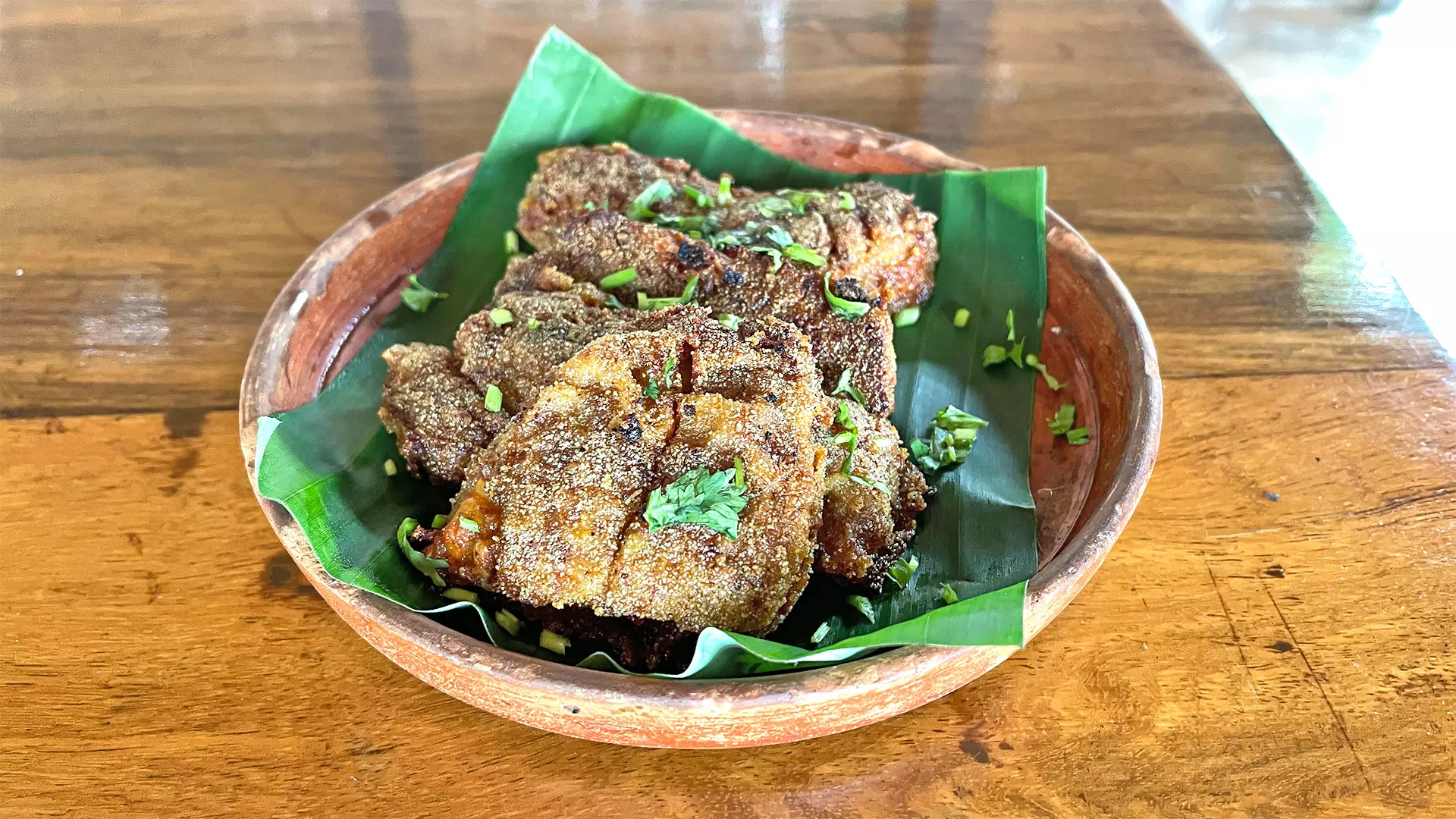
A standout in Malvan cuisine is the rava (semolina) coated fish.
The meal had its share of delights, but the true surprise, meticulously prepared for the very end, was a plate of Konkan-style modaks. Watching them come together is a performance in itself, as intricate as the final product. The Konkan coast brings a delightful twist to the classic modak. Delicate rice flour dough, meticulously pinched into elegant folds by chef Bavkar, cradled a rich and textural mixture of shredded coconut, jaggery's deep sweetness, and the surprise of dry fruits bursting with character. These little parcels are then steamed, allowing the filling's aromas to waft through. Served alongside is a luscious coconut sauce, gently sweetened to complement the Modak's natural flavours, creating a dessert that not only delights the palate but also honours the cultural heritage of Konkan cuisine. It wasn't just a dessert, it was a celebration of Konkan heritage, a perfect coda, a delicious ode, to tradition served on a plate.
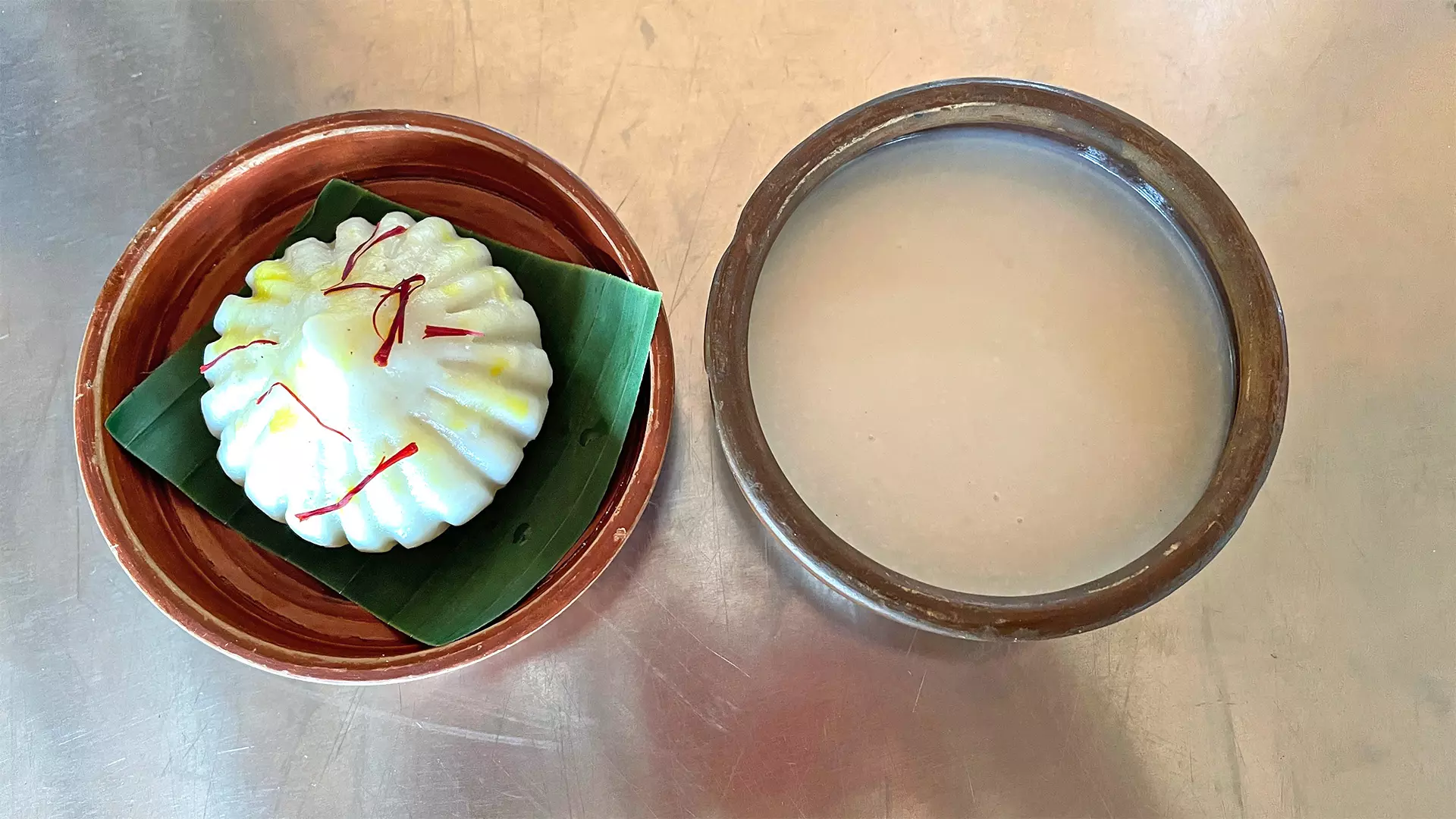
Watching the Konkoni modak come together is a performance in itself.
The artistry extended beyond the food itself. Each dish found its home in a unique earthen pot, these clay vessels known by tribal names like Budkula, Chul, Golee, Malti, and Sorkul in Malvani and Konkani. Their diverse shapes added a rustic touch to the presentation. Dry dishes, on the other hand, rested on flat plates adorned with a single banana leaf. The raw banana leaf and the earthy aroma of the clay pots subtly transform the flavours. For me, this unassuming presentation, reflecting the region's simplicity in its purest form, was what truly elevated each dish.
Suhas also offered a refreshing curry leaf lemonade alongside the meal. He was happy to share the recipe, “Blend curry leaves with a little water, then strain out the juice. Set it aside. Make some lemonade with honey, and when you're ready to drink, add the curry leaf juice and stir it well.” Suhas has one key tip, “Wait to mix the curry leaf juice with the lemonade until you're ready to serve. If you have extra curry leaf juice, store it separately and add it to the lemonade only when you want to drink it.”
Sindhudurg stands at the confluence of two distinct culinary traditions: the fiery Malvani and the gentle Konkani. Its strategic coastal location has not only shaped its history but also its cuisine. The district’s kitchens are a treasure trove of recipes, where the bold flavours of Malvani spices meet the subtle nuances of Konkani cooking.
Sindhudurg’s cuisine is also blessed by the unmatched freshness of its ingredients. From garden-fresh vegetables and fruits to seafood just pulled from the Arabian Sea, the region boasts a bounty of nature’s finest. This unparalleled freshness is the secret ingredient that elevates every dish, creating a unique gastronomic experience.
